9.4 /10 1 Votes
9.5/10 IGN Composer(s) Shinobu Tanaka Initial release date 14 November 2005 Designer Shigeru Miyamoto | 4.6/5 Emuparadise Genre(s) Racing Publisher Nintendo | |||||||||||||||||||||||||||||||||
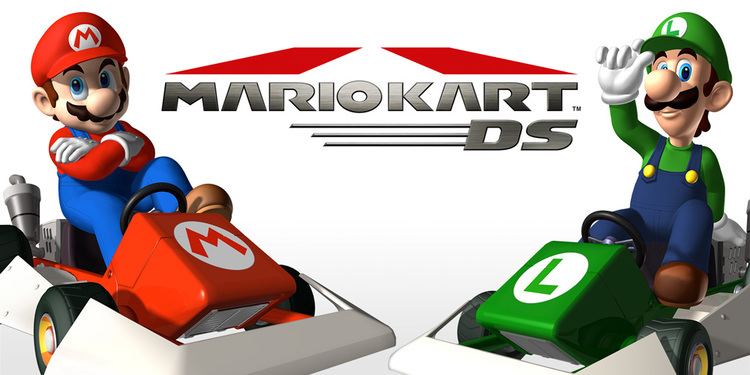 | ||||||||||||||||||||||||||||||||||
Director(s) Makoto WadaYasuyuki Oyagi Developers Nintendo, Nintendo Entertainment Analysis & Development Similar Mario Kart games, Nintendo games, Racing video games | ||||||||||||||||||||||||||||||||||
Nintendo ds longplay 073 mario kart ds part 1 of 3
Mario Kart DS (マリオカートDS, Mario Kāto Dī Esu) is a 2005 go-kart racing game developed and published by Nintendo. It was released for the Nintendo DS handheld game console on November 14, 2005 in North America, on November 17, 2005 in Australia, on November 25, 2005 in Europe, on December 8, 2005 in Japan, and on April 5, 2007 in South Korea. The game is the fifth installment in the Mario Kart series of video games, and the first to be playable via the Nintendo Wi-Fi Connection online service; the service has since been terminated, along with other games playable via the service. Like other games in the series, Mario Kart DS features characters from the Mario series, and pits them against each other as they race in karts on tracks based on locations in the Mario series.
Contents
- Nintendo ds longplay 073 mario kart ds part 1 of 3
- Mario kart ds special cup 150cc
- Gameplay
- Game modes
- Development
- Reception
- References

The game was very well received, receiving an aggregated score of 91% from Metacritic. Praise focused on the game's graphics and gameplay, while criticism targeted its repetitive single-player mode. Mario Kart DS received several awards, including Editors' Choice Awards from GameSpot and IGN, G-Phoria's Best Handheld Game award, and IGN's Best Racing/Driving Game Mario Kart DS was the best-selling game in its first month of release, and also held that position the following month. Overall, Mario Kart DS is the third best-selling game for the Nintendo DS as of March 2016, with 23.60 million units sold worldwide.
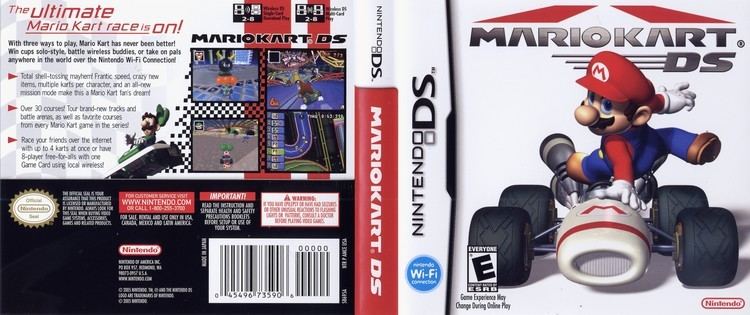
Mario kart ds special cup 150cc
Gameplay
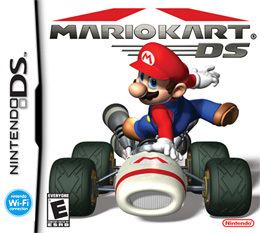
Mario Kart DS is a racing game, in which the player races in a kart against other racers as one of eight characters, each with three karts to choose from. While racing or battling, the Nintendo DS's top screen offers a third-person perspective of the player's kart, while the bottom touchscreen shows the race's current standings, items carried by each racer, and a map of the course. The bottom screen can be toggled to show either an overview of the entire course, or a bird's-eye view of the players kart and the immediate vicinity, including nearby racers, course hazards, item boxes, and incoming attacks. Each course features item boxes that the player can drive through to receive a randomly selected item, which the player can use to gain an advantage over other racers. Some items allow the player to attack other racers to slow them down, while other items can be used to speed up the player's own kart to pass other racers more easily.
Game modes
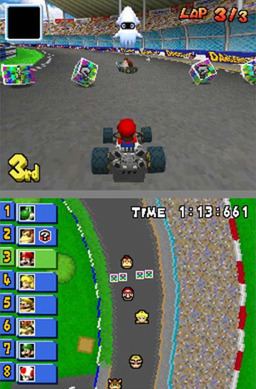
The game features 5 single-player game modes: Grand Prix, Time Trial, Versus, Battle, and Mission. The Grand Prix and Vs modes require that the player choose an engine class from among 50 cc, 100 cc, 150 cc, and Mirror. The classes serve as difficulty levels—the higher the engine class, the faster all karts go. In addition, a Mirror mode can be unlocked, in which karts use 150 cc engines and tracks are flipped vertically. In Grand Prix mode, the player competes against 7 computer-controlled racers in a series of predetermined courses. Unlike previous Mario Kart games, which featured 4 playable cups, Mario Kart DS features a total of 8 cups: Mushroom, Flower, Star, Special, Shell, Banana, Leaf and Lightning, with the latter 4 cups consisting entirely of tracks drawn from previous entries in the Mario Kart series. Each cup has four tracks for a grand total of 32. When a cup is completed, a rating will be given based on the times and positions, ranging from E to A, then to 1, 2 or 3 stars. Just like in Double Dash, players received points for each finishing position. In Time Trial mode, the player must finish a course as quickly as possible by using 1, 2 or 3 mushrooms (depending on which kart is used). The fastest time is then saved as a ghost, a copy of the player's performance, which the player can race against later. In Vs mode, the player races on a track of their choosing either against computer-controlled opponents or in local multiplayer. The mode can be played either individually or in teams, which separates racers into a blue team and a red team; in multiplayer, players can control which team they are placed on. In addition, the number of races played and scoring system can also be modified. Battle mode features two game modes, Balloon Battle and Shine Runners, both which also allow the player to play either individually or in teams. In Balloon Battle, the player must pop the balloons of the opposing players by attacking them, or they can steal balloons by boosting into other karts. Each participant starts the battle with 1 balloon. These can be re-inflated up to 4 times. In multiplayer, if a human player loses all of his/her balloons, he/she is out of the game and turns into a ghost. As a ghost, a player can only place item boxes. If the battle is played in single player, then the match ends and the results are announced when all of the human player's balloons are popped. In the second scenario, Shine Runners, the player must collect Shine Sprites (an object from Super Mario Sunshine). The player can attack other racers to take away a Shine Sprite from them, and racers with the fewest Shine Sprites are eliminated from the game over time. In single player, if the human player is eliminated from the round, the game ends and the results are randomized.

In Mission Mode, the player must complete missions, each with objectives that range from collecting coins to attacking enemies. In each mission, the player controls a prespecified character. There are seven levels with eight missions in each. After completing each mission, the player's performance is given a grade of stars (three, two, or one) or letters (A, B, C, D, or E). After all eight missions in a level are complete, the player must complete a boss mission to advance to the next level. Once the first six levels are complete, and the rank of at least one star has been obtained on every mission, the seventh level is unlocked.

The game also features a multiplayer mode, in which 8 players race each other using the DS Download Play feature or a multi-card wireless LAN connection. Until its discontinuation on May 20, 2014, Mario Kart DS supported online play via the Nintendo Wi-Fi Connection, in which up to 4 players could play together. When playing online, participants could only race against each other; Battle mode is not available when playing via an online connection. These features are not available in the Wii U VC version because the multiplayer features have not been emulated. R.O.B. is a middleweight character.
Development
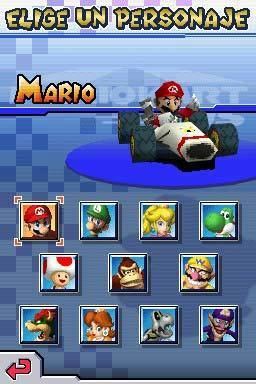
Nintendo first announced on May 11, 2005 that they planned to release a Mario Kart game for the Nintendo DS, releasing some gameplay video footage at the same time. The company offered the game for the public to play for the first time at the 2005 Game Developers Conference, where the game's wireless feature was also showcased. Mario Kart DS was produced by Hideki Konno, who also worked on 2005's Nintendogs. The game runs at a consistent 60 frames per second and uses full 3D characters and environments.
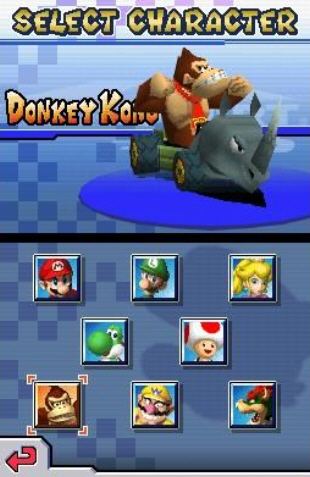
Mario Kart DS is the first Mario Kart iteration to support online play. Konno remarked that although both Mario Kart DS and the Halo series of games feature online play, he noted that most of the people who use the feature in Halo games were "hardcore gamers". With Mario Kart DS, Konno wants "everyone to go online, and the technology and time is right for that to happen". Continuing with the tradition of introducing a new gameplay mechanic in each Mario Kart game, Mario Kart DS is the first in the series to support up to eight players at the same time with game cartridges. New to the series, the game also includes a single-player Battle Mode, which does not require that there be at least two human participants. As the first Mario Kart game for the Nintendo DS, the developers tested several features that took advantage of the device's bottom touchscreen. They considered letting players place items anywhere on the track instead of just behind their kart. However, the developers found it too confusing because the game already had too many distractions, making it difficult to control where to place items while racing.
In Mario Kart DS, a kart is able to draft behind another kart to gain a speed boost momentarily, a feature that was also previously used in the 1996 video game Mario Kart 64. Mario Kart DS places a stronger focus on the feature and once again provides a visual cue when a kart is drafting. In an interview, Konno notes that they included tracks from previous Mario Kart games into Mario Kart DS so that players who played the original Super Mario Kart on the Super Nintendo Entertainment System would feel more familiar with the DS iteration of the series.
The game's soundtrack is composed by Mario Kart: Double Dash composer Shinobu Tanaka with voices by Kazumi Totaka, Charles Martinet, Deanna Mustard and more.
Reception
Mario Kart DS was released by Nintendo for the Nintendo DS in North America on November 14, 2005, in Australia on November 17, 2005, in Europe on November 25, 2005, in Japan on December 8, 2005, and in Korea on April 5, 2007. Nintendo later revealed that Mario Kart DS would also be sold bundled with a new red-colored Nintendo DS starting on November 28, 2005, along with "a checkered-flag wrist strap, and racing-inspired decals to customize new red handheld". The game was released to critical acclaim; it hold aggregated score of 91% on Metacritic. Praise focused on the game's graphics and gameplay, while criticism targeted its repetitive single-player mode. Mario Kart DS received Editors' Choice awards from GameSpot and IGN. The game was nominated by GameSpot for several Best of 2005 awards, including Best Multiplayer Game, Best Driving Game, and Best DS Game, winning the last one. The game received G-Phoria's Best Handheld Game award. IGN gave the game the awards for Best Racing/Driving Game.
Several reviews praised the game for living up to the standards set by its predecessors. Finding the game's online shortcomings annoying, GameSpy still believed that the single-player mode and local wireless gameplay more than made up for them. Nintendo World Report noticed that "the best features of past Mario Kart games are back" and work well with the new features in Mario Kart DS, calling the end result "the most impressive game to ever hit the Nintendo DS and also the best game in the Mario Kart series". X-Play shared this sentiment, and remarked that the game shattered all of its expectations, making it the "best kart racing game ever released—handheld or otherwise". GameZone also believed that Mario Kart DS "lives up to its legacy" with its inventive courses, "stellar" multiplayer, and "more replay value than any other racer in its class". Alejandro K. Brown of CBS News appreciated the game's unique use of Nintendo DS features, such as its microphone and wireless connectivity. GamesRadar named Mario Kart DS the best DS game of all time, beating out Pokémon Black and White (2nd) and Grand Theft Auto: Chinatown Wars (3rd).
Finding it hard to imagine how Nintendo could make a Mario Kart game better than Mario Kart DS, IGN lauded Mario Kart DS's gameplay and depth in its design. GameSpot called the game a "significant step forward" for the Mario Kart series, partly because it is the first in the series to feature online play. Game Revolution remarked that the game "goes the distance" with its single-player and multiplayer modes. 1UP.com complimented the "surprisingly compelling package", describing it as a "portable racing game on par with anything ever to appear on a console". Video game magazine GamePro was pleased with the variety of racers, courses, modes, and multiplayer options offered, toting the game as a "must play" for any Nintendo fan and a requisite for any Nintendo DS owner to purchase. Computer and Video Games described Mario Kart DS as the "most complete" Mario Kart game, despite a few graphical shortcomings. Eurogamer enjoyed the game's multiplayer mode, calling it "genuinely practical to play with other people". British publication GamesTM criticized the game for being simply a "polishing of the Mario Kart concept and little else", and video game website Nintendophiles was disappointed with the "fairly repetitive" single-player mode and the "cheap computer players".
The game was the first for the Nintendo DS to take advantage of the console's Nintendo Wi-Fi Connection feature. By the end of its debut week in the United States, 112,000 people purchased the game, of which 52,000 of them had logged onto Nintendo Wi-Fi Connection to play against other people over the Internet. Mario Kart DS was the best-selling handheld game in its debut month of November 2005 in the United States. It was the 10th best-selling game of 2008, and the best-selling Nintendo DS game of that year. In Japan, the game sold 224,411 copies in its first week. Mario Kart DS sold 3,112,363 units as of July 2008, and 3,224,996 copies as of January 2009, making it the sixth best-selling game for the Nintendo DS since the console's release. As of March 2016, Mario Kart DS has sold 23.60 million units worldwide.
